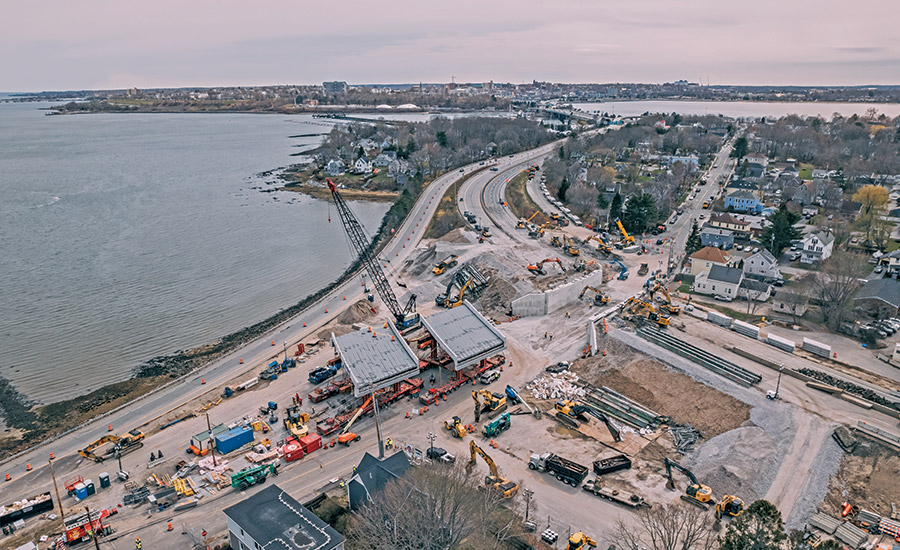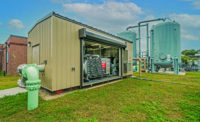Well into the third year of COVID-19, executives of general contractors and construction managers in ENR’s New York and New England regions have seen activity and revenue growth return—bolstered by certain healthy sectors and by jobsite and workplace innovations at their companies.
The top 10 contractors and CM firms in New York and New Jersey reported $16.49 billion in combined 2021 revenue, up 12% from the $14.73 billion that the region’s top 10 reported a year ago. Among the top 50 listed firms, total regional revenue last year rose 3% to $25.52 billion from $24.76 billion. The 2022 ranking lists a total of 58 responding firms.
New England saw even more impressive regional revenue growth. The top 35 companies that performed work in Connecticut, Maine, Massachusetts, New Hampshire, Rhode Island and Vermont reported $15.48 billion in total 2021 revenue. That is up 27% compared with the $12.2 billion the same number of firms reported on last year’s ranking. There are 44 ranked New England respondents this year.
Related Links
ENR New York 2022 Top Contractors Rankings
ENR New England 2022 Top Contractors Rankings
Both regional Top Contractors lists each show the top three firms generally maintaining their revenue positions. ENR New York’s top two contractors remain the same, with AECOM Tishman at No. 1 and Structure Tone/Pavarini McGovern/RC Anderson in second place. Turner Construction Co. was able to jump one place this year to No. 3, while Skanska USA dropped to fourth in the main ranking. The ENR New England ranking shows the same contractors in the top three slots, with a position switch for two firms. Suffolk Construction Co. holds on to the No. 1 regional spot, while Consigli Construction Co. rose one place to No. 2 and Turner Construction Co. slid to third.
Executives from each region shared with ENR how they have managed pandemic hurdles and speculate on what sectors offer the greatest construction and revenue opportunities.
Andy D’Amico is president and CEO of New York City-based Urban Atalier Group. The firm posted a 61% rise in 2021 revenue, to $308 million, and holds the No. 23 spot in the New York regional ranking. Dan Guimond is senior project manager at Corderman & Co. in Boston. Ranked at No. 35 on the New England list, the firm reported $80 million in 2021 revenue, which stayed steady with what the firm reported for the prior year.
Their answers have been edited for length and clarity.
What lessons from the last two years have most shaped the way you do business now?
D’Amico: No one could have predicted the global pandemic, Russian-Ukrainian war, supply chain pressures and inflation. These challenging times have made us more conscious and selective of who we partner with. We’ve reinforced and cultivated our long-standing partnerships and built a level of trust where we can foresee and mitigate challenges to support one another. We better understand our partners’ financial stability and where products and materials come from throughout the country and worldwide, which helps us manage risk downstream and client expectations.
Guimond: We have experienced COVID-19, record material cost increases, supply chain disruptions and labor shortages, all of which have continued alongside further energy price complications generated from international conflicts. This has led to a predominantly remote workforce with a focus on technology, health care and sustainability. We also use cloud-based 360° scanning software that turns our projects into navigable 3D models that our clients and design teams can virtually walk through—facilitating greater collaboration and communication, accountability and project predictability.
Which sectors have offered the biggest opportunities in your region?
D’Amico: The residential and commercial sectors have offered the most significant opportunities for us. With rents at an all-time high, there has never been a greater need for more affordable housing in the region. As a result, we’re actively constructing several market-rate and affordable rental developments. While the commercial marketplace has been challenged, resulting in several vacant properties around New York City, many commercial developers have viewed this as an opportunity to rethink the workplace. From our conversations with clients, we see an expectation to construct or convert commercial developments to “humanize” the workplace—with shaded workspaces, cabanas for gathering, wellness areas, walking paths and a variety of social spaces ... [and] vast skylights that allow for ample natural light.
Guimond: From our perspective, we have seen increases in the health and wellness, banking, corporate and institutional sectors. Many employers now are returning to the workplace or expanding their hybrid model. Colleges and universities that paused their capital projects now have renewed spirit since students have returned to in-person classes and are also beginning to move forward with developments.
Which sectors have cooled down in your region?
D’Amico: One industry that has struggled to bounce back is hospitality. While some projects have reengaged, this sector is still slow to rebound largely due to concerns about tourism post-pandemic. While we are constructing several condominium buildings with two major projects in the pipeline, we have seen a slight slowdown. We believe this is a result of new life-work arrangements. The flexibility of work-from-home has allowed people to live outside the city.
Guimond: The corporate and retail sectors slowed down over the last two years due to business closures and a shift to the remote work model. We are now beginning to see a robust 2022 first quarter due to pandemic fatigue and reduced public health policies.
What key innovations helped you boost productivity or other metrics?
D’Amico: Reflecting on how we used to operate pre-pandemic, we have significantly streamlined our workflow and productivity since working from home. For example, at the height of the pandemic, our employees quickly adapted to using videoconferencing tools such as Microsoft Teams to connect with one another and our clients. Now that we’re back in person, there is still comfort and familiarity with the software that has helped transform the in-office experience and make meetings more productive and efficient. Additionally, we’ve streamlined workflow via DocuSign. We have gone from stacks of paper contracts and service agreements that had to be manually signed to a more sustainable approach.
Guimond: Increased technological advances with artificial intelligence, process automation and data sharing have bolstered our ability to manage larger volumes of work without increasing staff and overhead. These advances should continue as remote work and hybrid models continue to evolve for most workers.







Post a comment to this article
Report Abusive Comment